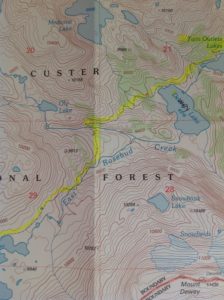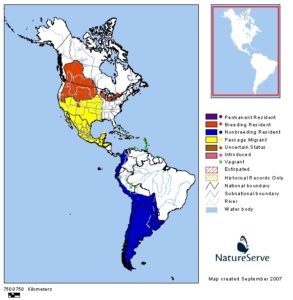

Our footpath, the birds’ flight path
I never expected to see a flock of shorebirds amongst the high peaks of Montana’s Absaroka-Beartooth Wilderness last week.
Golden eagles, yes. Elk and mule deer and marmots, yes. Single spotted sandpipers, sure.
But there they were, in a synchronous flock, spinning like snowflakes over glacial Dewey Lake, more than 9000 feet above sea level.
I don’t carry my excellent binoculars backpacking anymore. In my 60s, I aim to shoulder the lightest possible weight on our seven-day hikes (somewhere in the neighborhood of 25 pounds).
So I marked those creatures up to a mystery I wouldn’t solve, given the distance that separated us.

Here’s the best view we had (courtesy of Ian MacDonald)
The next day, as we descended more than 2000 feet and 8 miles along the staggeringly beautiful Twin Outlets, Duggan, Lake at Falls and Rainbow lakes, more flocks appeared.

Nine thousand feet, Rainbow Lake. Not the Gulf Coast staging areas I’m used to!

Red-necked phalarope in winter plumage, (courtesy of tgreybirds.com)
I’d never seen a phalarope before, let alone 100 at a time, but even from afar, I knew that’s what we were observing. Most likely, red-necked phalaropes.

The amazing global passage of red-necked phalaropes. Map courtesy of Natureserve.com
My shorebird references here at home tell me those flocks were migrating from Alaskan or Arctic breeding grounds to their wintering territories in South America.
As I watched the shorebirds spin and jab like small dervishes in the open waters of the mountain lakes, I was freshly astounded by the fact of long-distance migration. For tens of thousands of years, birds perfected routes and destinations to improve their options on planet Earth. But with human-induced climate change and development, many species are declining.
I probably won’t spot phalaropes on my coastal outings and counts here in North Florida in the months to come. But I hope the spectacle and the privilege of seeing those high-altitude shorebirds will fuel my activism.
Whether the migrants you see in your daily life are hummingbirds or swallow-tailed kites or phalaropes, now is a good time for you to strengthen your voice on behalf of these marvelous creatures. This week marks the hundred-year anniversary of the Migratory Bird Treaty signed between the United States and Great Britain on August 16, 1916. You can join the celebration of birds by participating in the US Fish and Wildlife Service’s social media campaign https://www.fws.gov/birds/MBTreaty100/index.php
Share On:
Cool Sue. Sure wonder what they were!
Thanks for the thoughts, as always reminding us of the global connections that exist for the intricate web of life of our big spinning planet and how to serve it best.
Gretchen, it’s a dance we do together….
Thanks for sharing such a lovely, magical moment, Sue.